As an Amazon Associate KitchenwareSets.com earns from qualifying purchases.
11 Minimalist Japanese Kitchen Ideas for a Serene Space
Does your kitchen feel more like a source of stress than a center of calm? If you’re constantly battling overflowing drawers, crowded countertops, and a general sense of chaos, you’re not alone. The kitchen is the heart of the home, but when it’s disorganized, it can feel overwhelming, making simple tasks like preparing a meal feel like a monumental effort. This constant visual noise can drain your energy and detract from the joy of cooking and gathering.
You’ve likely tried countless organization tipss, but the clutter always seems to creep back in, leaving you feeling defeated. You’re searching for more than just a temporary fix; you’re looking for a sustainable solution that brings both beauty and function to your space. You need a design philosophy that transforms your kitchen into a serene, efficient, and inspiring haven.
The solution lies in a minimalist Japanese kitchen, which blends the philosophy of “less is more” with a deep respect for nature and functionality. This approach isn’t about deprivation; it’s about intentionality. It focuses on creating a serene, uncluttered, and highly efficient space by thoughtfully using natural materials, a muted color palette, and smart organizational strategies that bring a lasting sense of peace and order to your home.
The Philosophy: Understanding Wabi-Sabi and Japandi
At the heart of the modern minimalist Japanese kitchen are two key philosophies: Japandi, a design hybrid that merges Japanese minimalism with Scandinavian functionality, and Wabi-sabi, the Japanese worldview of finding beauty in imperfection. By understanding these concepts, you can move beyond simply copying a look and start creating a space with soul and intention. “By understanding these core philosophies, you can make more intentional design choices that reflect a deeper appreciation for craftsmanship and authenticity, rather than just following a trend.”
- Wabi-Sabi: This is the appreciation for the authentic, the imperfect, and the natural. It finds beauty in materials that age gracefully, like a worn wooden cutting board or a handmade ceramic bowl with a slightly uneven glaze. It’s about celebrating character over sterile perfection.
- Japandi: This popular style is the perfect marriage of two minimalist traditions. It takes the warmth, comfort (hygge), and high functionality of Scandinavian design and blends it with the serene elegance, natural elements, and refined craftsmanship of Japanese aesthetics. The result is a space that is both cozy and calming, practical and poetic.
11 Minimalist Japanese Kitchen Ideas for a Serene Space in 2025
Ready to transform your kitchen from chaotic to calm? This curated list of 11 tangible ideas will guide you through the core principles of minimalist Japanese design. We’ll cover everything from the foundational act of decluttering to the subtle art of choosing decor. Each idea is designed to be adaptable for any kitchen size or budget, proving that serenity is achievable for everyone. This curated list is based on extensive research into authentic Japanese design principles and modern Japandi applications, ensuring each idea is both beautiful and highly functional.
1. Embrace Radical Minimalism by Decluttering
The absolute cornerstone of a Japanese-inspired kitchen is embracing the “less is more” philosophy through rigorous decluttering. This means creating a visually quiet, spacious environment by eliminating every non-essential item and ensuring countertops remain clear and open. The goal is to create a sense of freedom where every object has a purpose and a designated home.
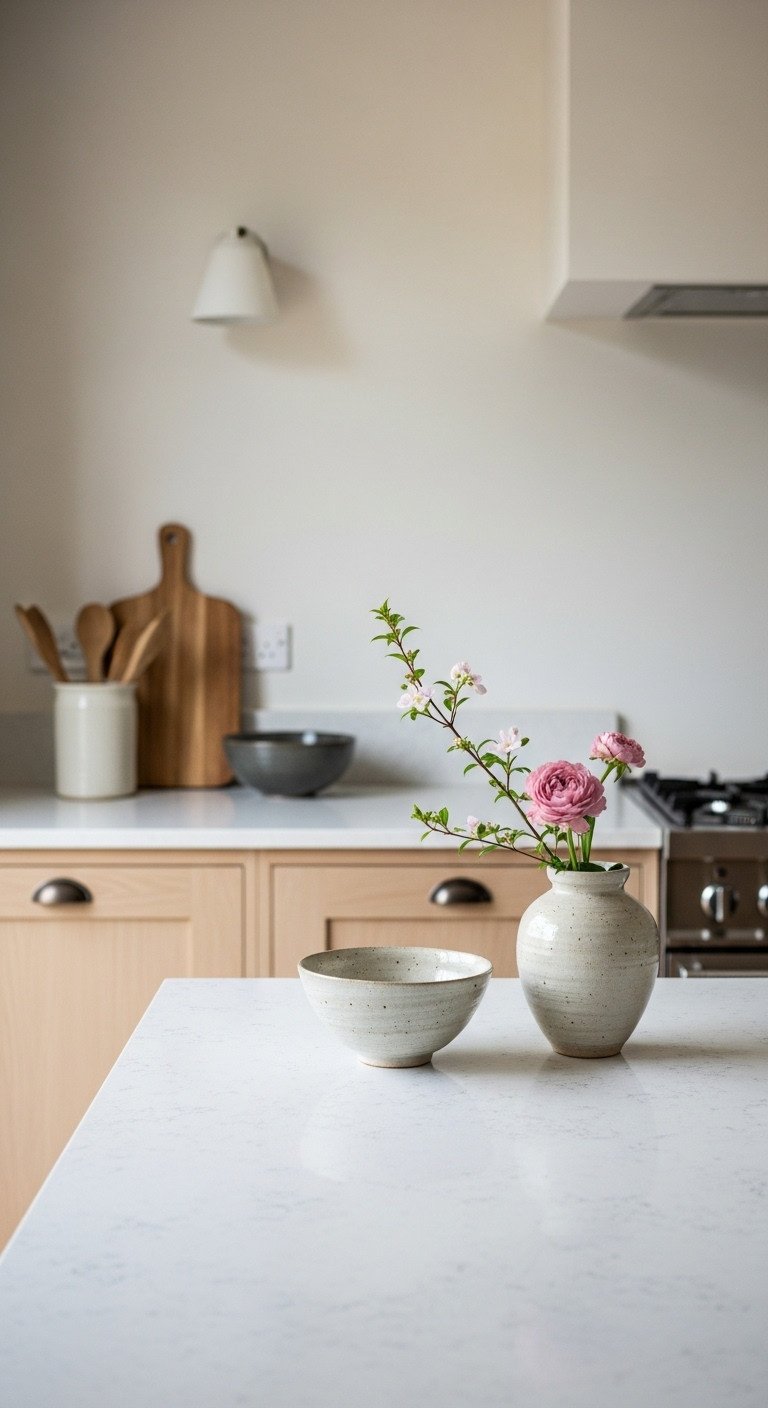
Save this serene inspiration to your “Mindful Home” board!
- Materials Needed: Drawer dividers, cabinet organizers, clear storage containers, donation box.
- Step-by-Step Directions:
- Empty one cabinet or drawer at a time. Be ruthless and purge anything you haven’t used in the past year.
- Group your remaining items by category (e.g., baking, cooking, prep) to understand what you truly have.
- Assign a specific, logical home for every single item. To maximize your internal cabinet space, use clever storage solutions.
- Inside deep cabinets, a tiered expandable shelf is perfect for seeing cans and spices. For drawers, a set of adjustable bamboo drawer dividers creates beautifully organized compartments for utensils and tools.
- The ultimate goal is to keep your countertops as clear as possible, storing small appliances in cabinets or an “appliance garage” when not in use.
Pro-Tip: The “one in, one out” rule is a game-changer. For every new item you bring into the kitchen, commit to removing one old item. This prevents clutter from creeping back in.
2. Prioritize Natural Materials for Warmth
Harmony with nature is paramount, and the quickest way to achieve this is by incorporating an abundance of natural materials. Wood, stone, bamboo, and natural textiles like linen and cotton bring warmth, texture, and a sense of grounding to the kitchen, creating a space that feels both sophisticated and connected to the earth.
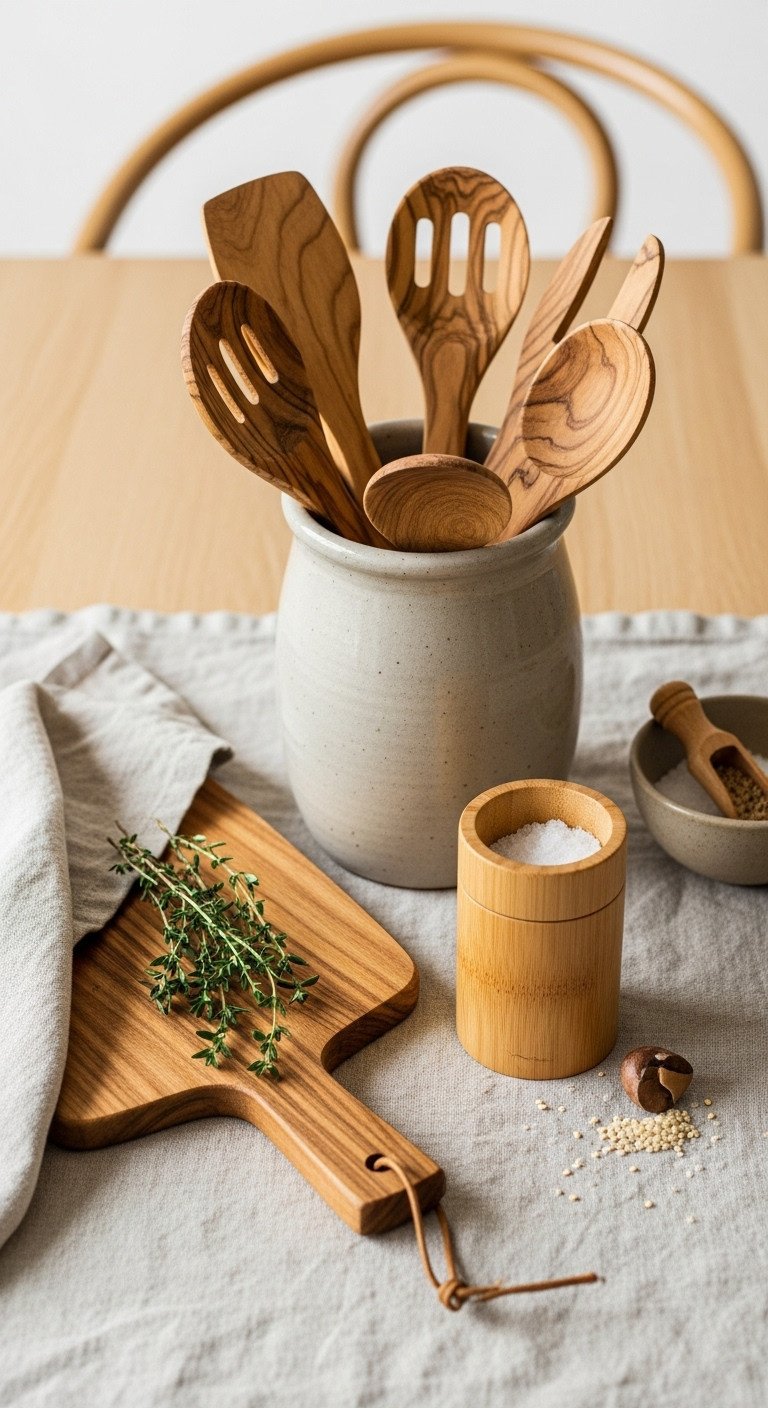
Pin this natural texture inspiration for your kitchen refresh!
- Materials Needed: Wooden cutting boards, bamboo organizers, linen dish towels, stoneware canisters.
- Step-by-Step Directions:
- Start with small, impactful swaps. Replace plastic cooking utensils and cutting boards with beautiful wood or bamboo versions.
- Select a beautiful, thick acacia wood cutting board and lean it against your backsplash. It serves as a functional tool and a stunning piece of decor.
- Store dry goods like flour, sugar, and coffee in simple stoneware or ceramic canisters on an open shelf to add earthy texture.
- Ditch paper towels for a stack of high-quality, absorbent linen or cotton dish towels in a neutral, muted color. They add a layer of softness and are wonderfully sustainable.
Lesson Learned: Not all woods are the same. For items like cutting boards and utensils that get a lot of use, choose hardwoods like acacia, teak, or maple for their superior durability and natural water resistance.
3. Adopt a Muted, Earthy Color Palette
The color scheme of a Japandi kitchen should highlight the beauty of the natural materials, not compete with them. A palette of muted and warm neutral tones—think sand, beige, cream, ivory, and soft taupe—creates an immediate atmosphere of serenity and calm while maximizing the feeling of light and space.
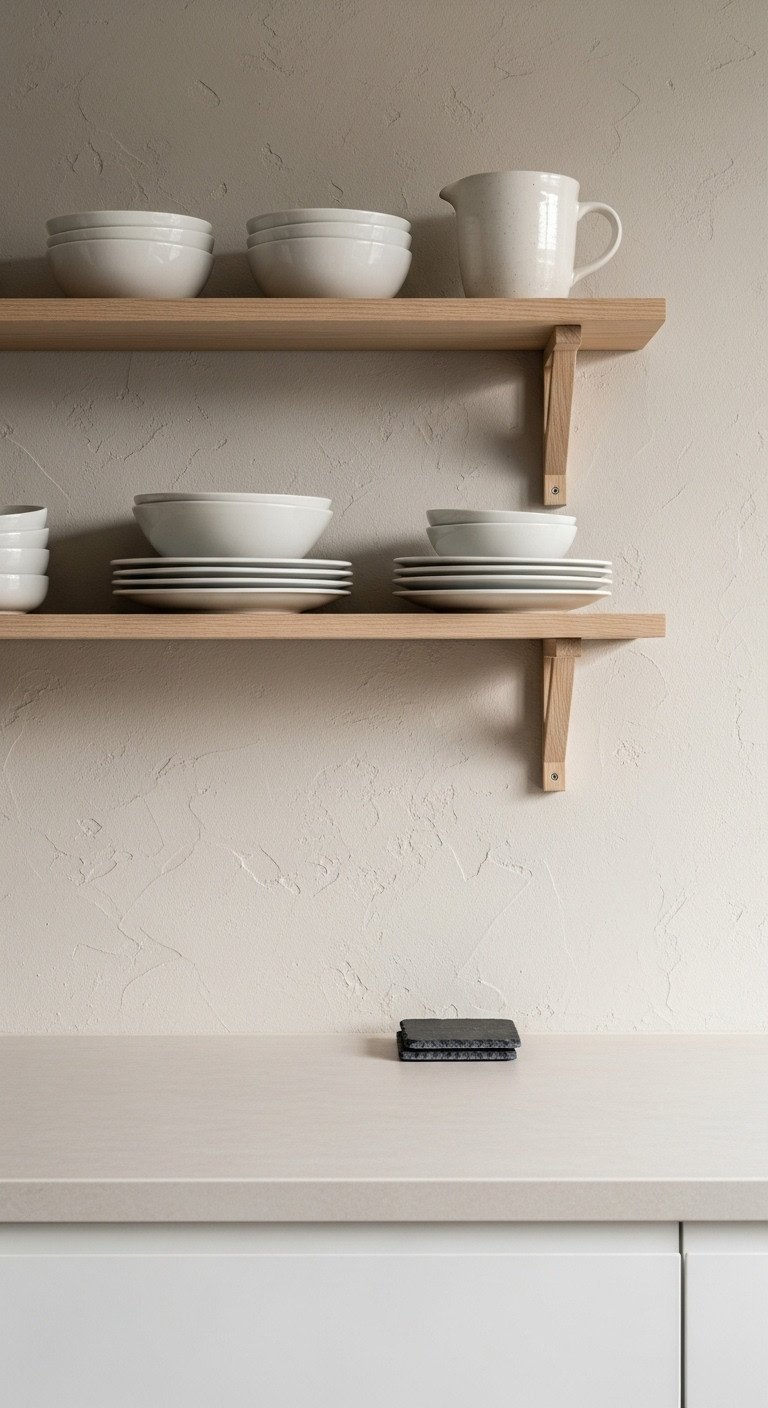
Love this color scheme? Save it to your “Dream Home” board!
- Materials Needed: Paint samples, high-quality paint, matte black cabinet hardware (optional).
- Step-by-Step Directions:
- Choose a primary neutral shade for your walls, such as a warm white, soft beige, or a light greige. It’s crucial to test paint samples on your wall first, as the natural and artificial light in your kitchen will dramatically affect the final color.
- Select a complementary color for your cabinets, which could be a slightly darker taupe or a beautiful light wood tone.
- Limit the use of bold, jarring colors. Instead, create visual interest by layering different textures within your neutral palette—a rough linen, a smooth stone, and warm wood.
- To add a touch of drama and definition, use black as a sharp accent. A sleek matte black faucet or a set of minimalist matte black cabinet pulls can ground the space and provide a sophisticated, modern contrast.
Pro-Tip: Pay close attention to the undertones in your neutral colors. A beige with a pink undertone will create a very different feeling from one with a green or yellow undertone. Hold your paint chips next to your fixed elements like countertops and flooring to ensure they harmonize beautifully.
4. Optimize Flow with Smart Organization
A Japanese kitchen design is meticulously planned to respect human movement and create an ergonomic, highly efficient workflow. Functional zones for prepping, cooking, and cleaning are logically arranged to minimize wasted steps, often incorporating “zen” principles for an unobstructed and comfortable flow.
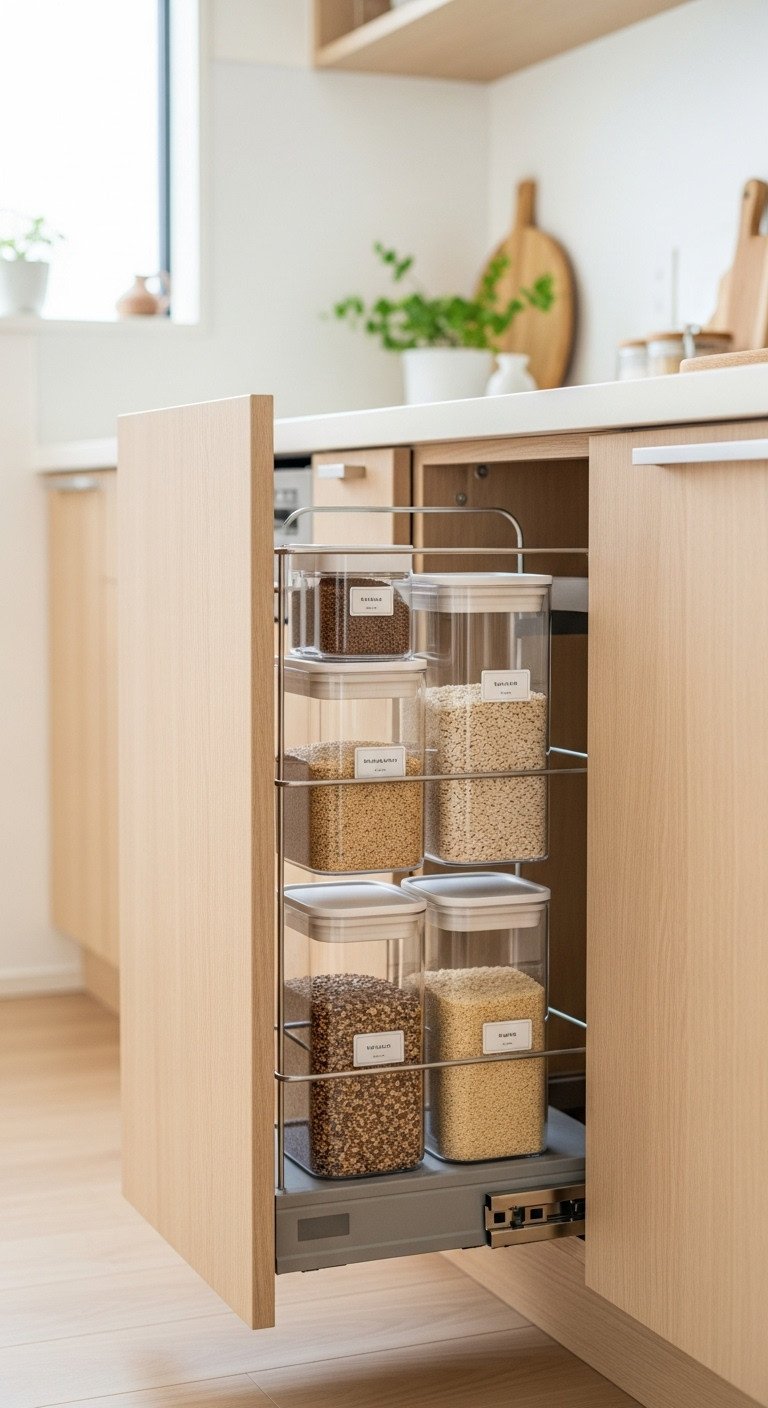
Get inspired to organize! Pin this clever storage solution.
- Materials Needed: Cabinet organizers, drawer liners, turntable organizer (Lazy Susan).
- Step-by-Step Directions:
- Take a moment to analyze your current workflow. Where do you waste steps moving back and forth? Group your items based on where you use them. Keep pots and pans near the stove, and knives and cutting boards in your primary prep zone.
- Make your most-used essentials easily accessible. Store frequently used items like olive oil, salt, and pepper on a small, elegant tray right next to the stove.
- Conquer the dreaded corner cabinet. Those deep, awkward corner cabinets are notorious for being black holes. Install a two-tiered lazy susan organizer to make every item easily reachable with a simple spin.
- Create functional “kits” to streamline routines. For example, designate one area as a coffee station with your mugs, coffee maker, beans, and sugar all conveniently located in one spot.
Pro-Tip: The Japanese concept of “zen” flow can be directly applied here. Ensure there are clear, unobstructed pathways between your main work areas: the sink, the stove, and the refrigerator. This classic “work triangle” is the foundation of a truly ergonomic and enjoyable kitchen.
5. Foster Openness with Light and Nature
A key principle in Japanese design is blurring the boundaries between the interior and the outdoors, creating a seamless connection to nature and maximizing natural light. This fosters a sense of openness and harmony, making the kitchen feel larger, brighter, and more alive.
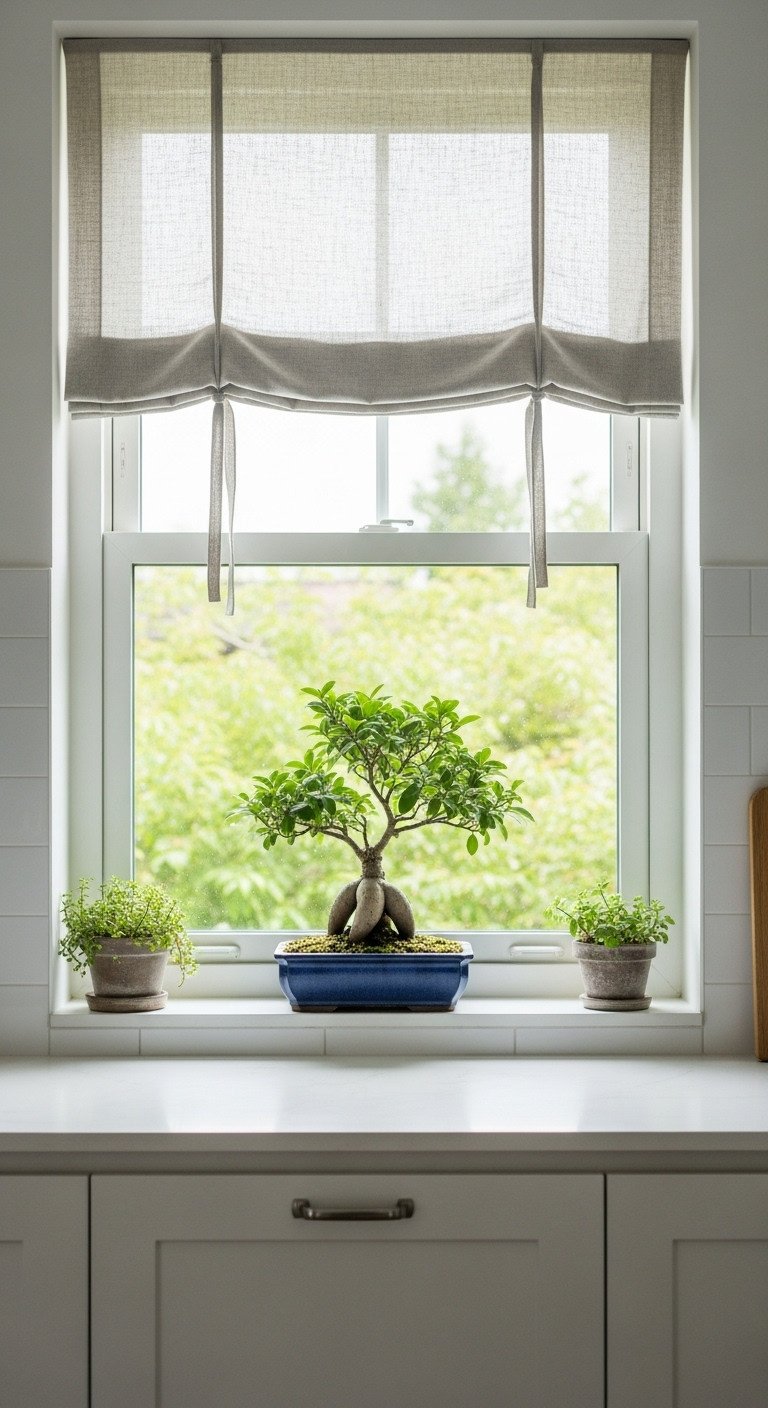
Pin this beautiful idea to bring more nature indoors!
- Materials Needed: Translucent linen curtains, tension rod, small indoor plants or herbs.
- Step-by-Step Directions:
- Replace heavy, light-blocking drapes or blinds with simple, airy window treatments. Unlined linen or cotton curtains hung on a minimalist tension rod will soften and diffuse the sunlight without sacrificing brightness.
- If you don’t have a pleasant view, create your own. Place a few small pots of fresh herbs like basil, mint, or rosemary on the windowsill. They add vibrant life, beautiful color, and are wonderfully functional for cooking.
- Keep the window areas themselves completely clear of clutter to maximize every bit of light that can enter the room.
- For a truly authentic Japanese touch, consider adding a small, easy-care bonsai tree to your windowsill. It acts as a beautiful piece of living sculpture.
Lesson Learned: Even in a city apartment with no garden view, you can still create a powerful connection to nature. A minimalist vertical wall planter can house several herbs or small plants, taking up zero counter space while adding a vibrant and refreshing touch of green.
6. Choose Thoughtful and Intentional Decor
In a minimalist space, every single decorative element must be chosen with intention and purpose. The goal is to select a very limited number of items that fit organically into the space, complementing the serene atmosphere rather than cluttering it. Less is always more.
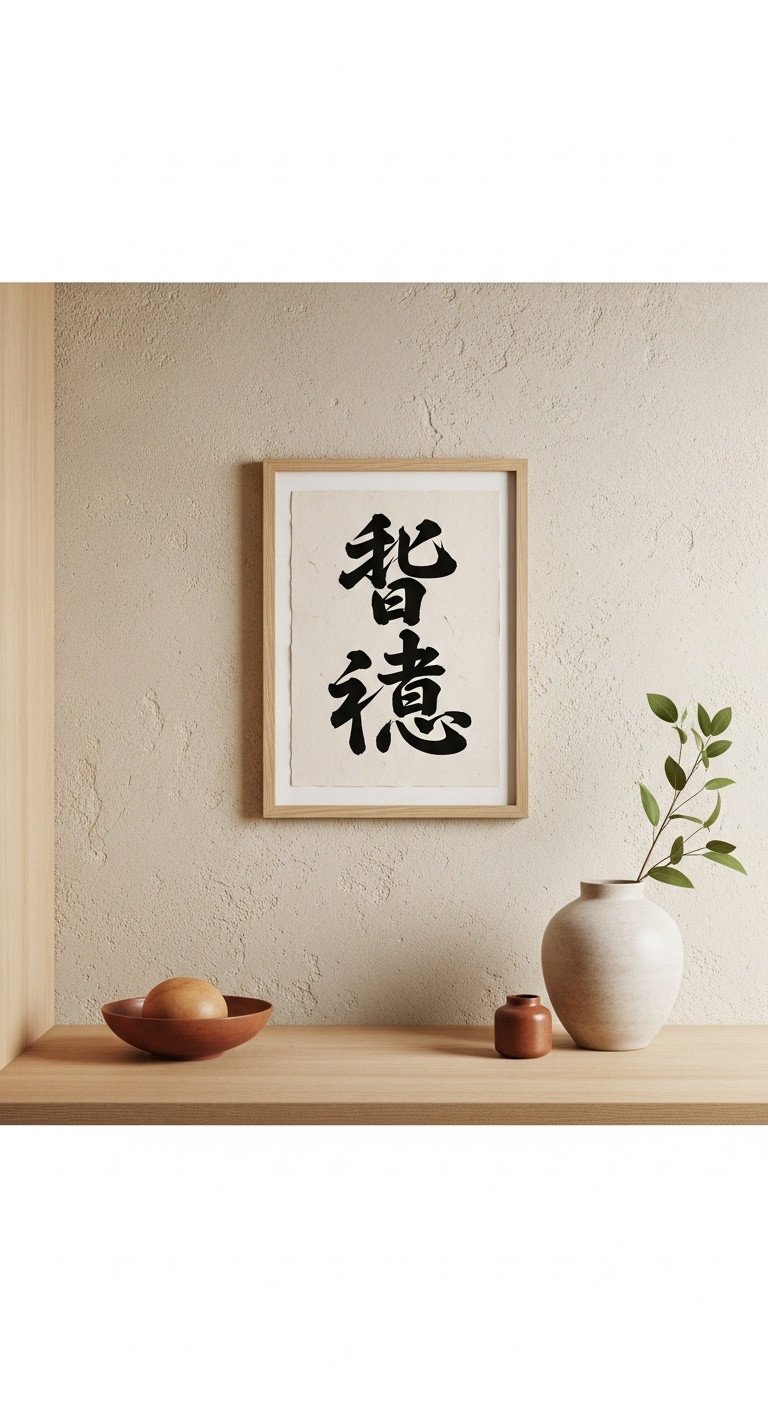
Save this simple decor idea for a touch of elegance!
- Materials Needed: Minimalist art print, simple frame, handmade ceramic vase.
- Step-by-Step Directions:
- Follow the “one in, three out” rule for decorative items. For every one new piece of decor you want to display, consciously remove three other items from the area to ensure your chosen piece has room to breathe and be appreciated.
- Prioritize decor that is also functional. A beautiful handmade ceramic utensil holder, a sculptural wooden salt cellar, or an elegant stoneware oil cruet all add beauty while serving a practical purpose.
- For wall art, opt for simplicity and meaning. A single, well-chosen piece has far more impact than a cluttered gallery wall. For an affordable and authentic option, you can find high-quality Japanese art prints online and frame them yourself in a simple, minimalist light wood picture frame.
- Add a touch of life and an organic shape by placing a single branch or a few delicate stems in a handmade vase.
Pro-Tip: Rotate your decor. Instead of having all your favorite pieces out at once, store a few of them and swap them out seasonally. This keeps the space feeling fresh and dynamic, and allows you to appreciate each beautiful item individually.
7. Layer Lighting for Ambience and Function
Lighting is a key decorative and functional element, and the best approach is a layered strategy that combines different types of light to create a space that is both functional and atmospheric. By blending ambient, task, and accent lighting, you can create a kitchen that is perfectly illuminated for cooking and has a soft, cozy glow for relaxing.
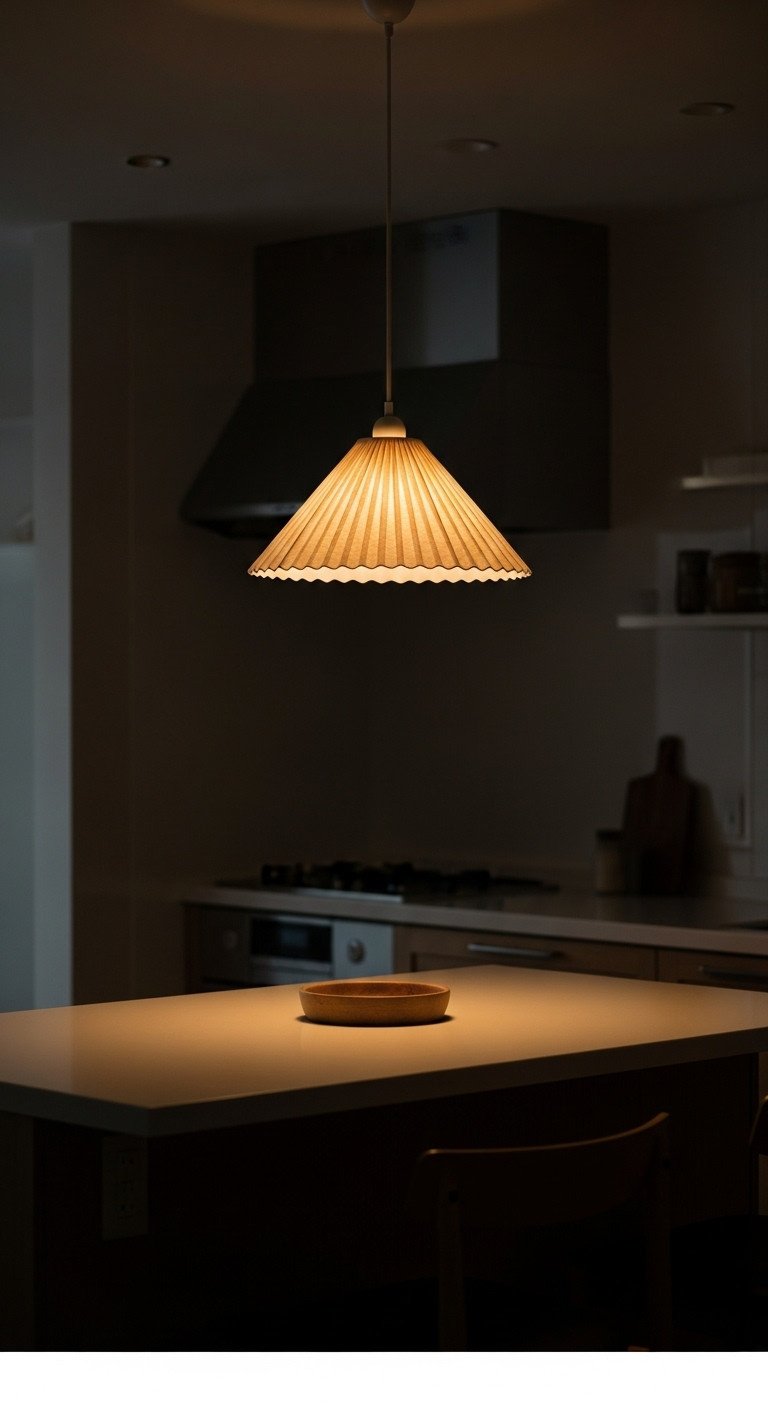
Pin this cozy lighting idea for your future kitchen!
- Materials Needed: Pendant light, under-cabinet LED light strips, dimmer switches.
- Step-by-Step Directions:
- Start with your ambient (overall) light from recessed or track lighting. The most important upgrade here is to install dimmer switches, which give you complete control over the mood of the room.
- Next, add focused task lighting. This is absolutely crucial for illuminating your countertops during food prep. The easiest and most effective way to add this is with a plug-in under cabinet LED light strip. These are simple to install and eliminate the shadows cast by your upper cabinets.
- Finally, incorporate an accent light. This is your statement piece. A beautiful pendant light with a natural paper, wood, or ceramic shade hanging over an island or dining area adds a sculptural element and a warm, inviting glow.
Lesson Learned: Always choose “warm white” (2700K-3000K) bulbs for your kitchen lighting. Harsh, cool-toned “daylight” bulbs (5000K+) can make a serene, natural space feel sterile, cold, and clinical.
8. Incorporate Sleek Surfaces and Clean Lines
The Japandi aesthetic is defined by an emphasis on clean, uninterrupted lines and sleek, simple surfaces. This is most often expressed through handleless, flat-panel cabinets and a commitment to keeping appliances hidden to maintain a streamlined and uncluttered appearance.
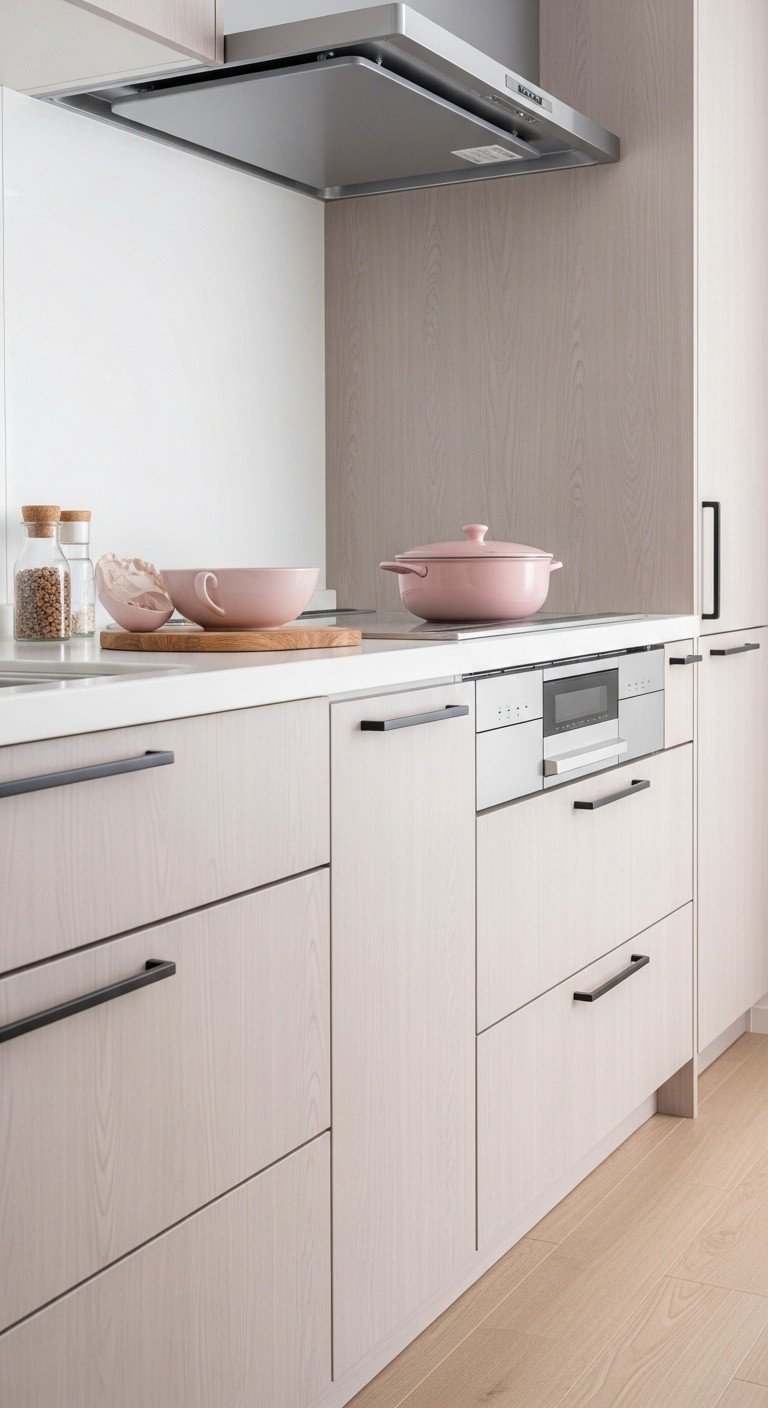
Save this sleek cabinet design to your “Kitchen Remodel” board!
- Materials Needed: Push-to-open cabinet hardware latches (for DIY), appliance garage, integrated appliances.
- Step-by-Step Directions:
- The foundation of this streamlined look is flat-panel cabinets. Avoid any ornate details, raised panels, or shaker-style doors.
- For the ultimate clean, uninterrupted look, opt for handleless cabinets that use integrated channels or push-to-open mechanisms.
- If you’re updating existing cabinets on a budget, you can achieve a minimalist look by removing the old hardware, filling the holes with wood putty, sanding, and painting. Then, you can install a discreet magnetic push-to-open cabinet door latch on the inside of the cabinet doors for a seamless, handleless effect.
- Keep small appliances hidden away. Integrated, panel-ready dishwashers and refrigerators are the high-end ideal. For a more budget-friendly option, an “appliance garage” with a retractable door is perfect for keeping toasters, blenders, and coffee makers out of sight.
Pro-Tip: Vertical lines can make a small kitchen feel taller and more spacious. Consider adding wood-slat details on the front of a kitchen island or as a feature wall to introduce clean, repeating lines that draw the eye upward.
9. Find Beauty in Imperfection (Wabi-Sabi)
While traditional design often seeks perfect symmetry and balance, the Wabi-sabi aesthetic celebrates the beauty of imperfection, asymmetry, and aging materials. This philosophy can be expressed through raw, tactile materials like rough-sawn wood, stone with visible marks, and ceramics with beautifully uneven glazes.
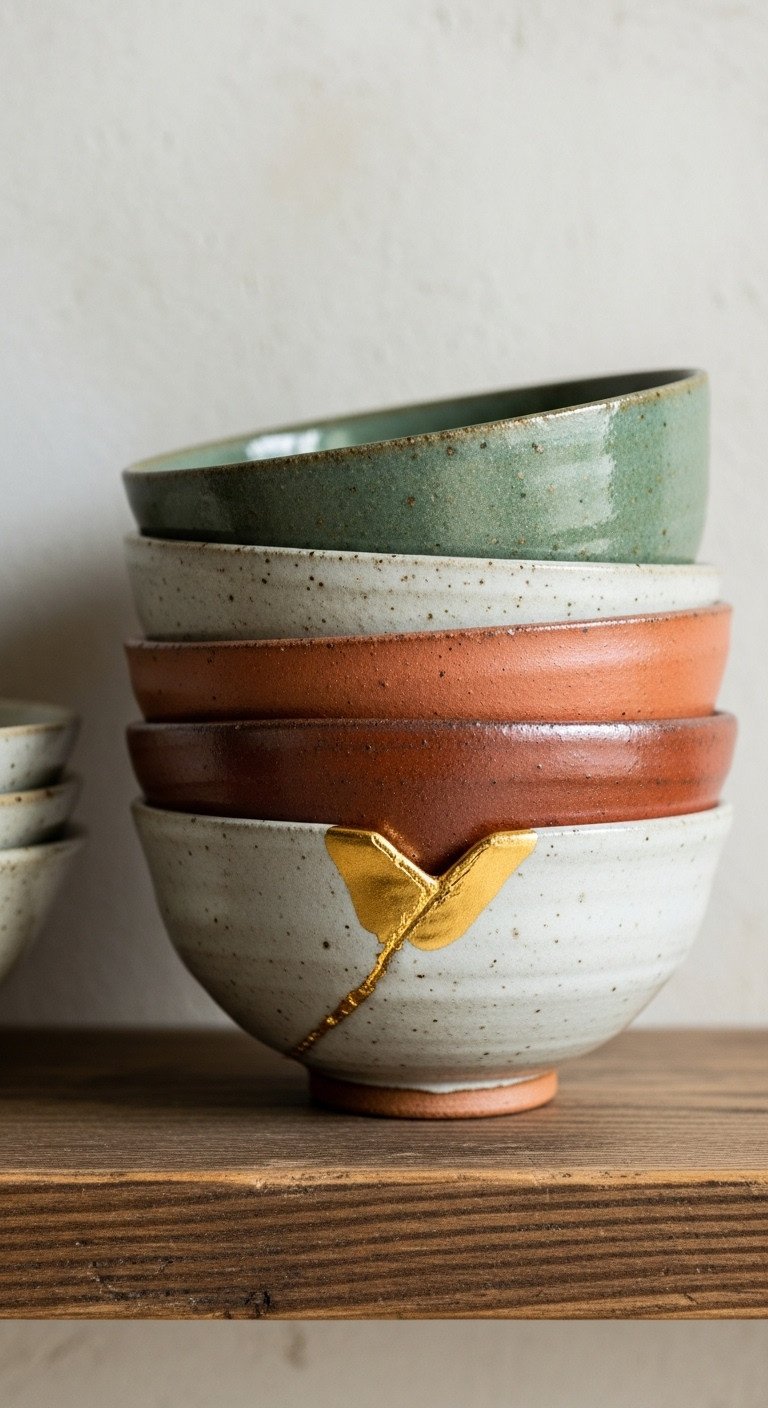
Pin this beautiful reminder that imperfection is stunning.
- Materials Needed: Handmade ceramic tableware, unsealed stone coasters, linen napkins with natural edges, DIY Kintsugi repair kit.
- Step-by-Step Directions:
- Swap out your mass-produced, identical dinnerware for a set of handmade ceramic plates or bowls. The slight variations in shape, color, and glaze celebrate the artist’s touch and add immense character.
- Choose functional items with visible, natural texture, like a dark slate serving board, unsealed travertine coasters, or a live-edge wood shelf.
- Learn to appreciate the signs of age and use. A small scratch on a wooden countertop or a developing patina on a brass fixture tells a story and adds to the soul of your kitchen.
- If a treasured ceramic piece breaks, embrace the art of Kintsugi. You can purchase a food-safe DIY Kintsugi repair kit to beautifully mend the broken pieces with gold, turning the “flaw” into the piece’s most beautiful feature.
Lesson Learned: True Wabi-sabi is about authenticity, not manufactured distress. It’s better to choose high-quality materials that will naturally age and develop character over time, rather than buying pre-distressed items that lack a genuine story.
10. Integrate Shoji-Inspired Elements
For a more traditional touch, you can incorporate modern interpretations of classic Japanese elements like Shoji screens. Traditionally made of translucent paper and wood, these screens can be reimagined using materials like frosted glass to add a beautiful, light-diffusing element to your kitchen.
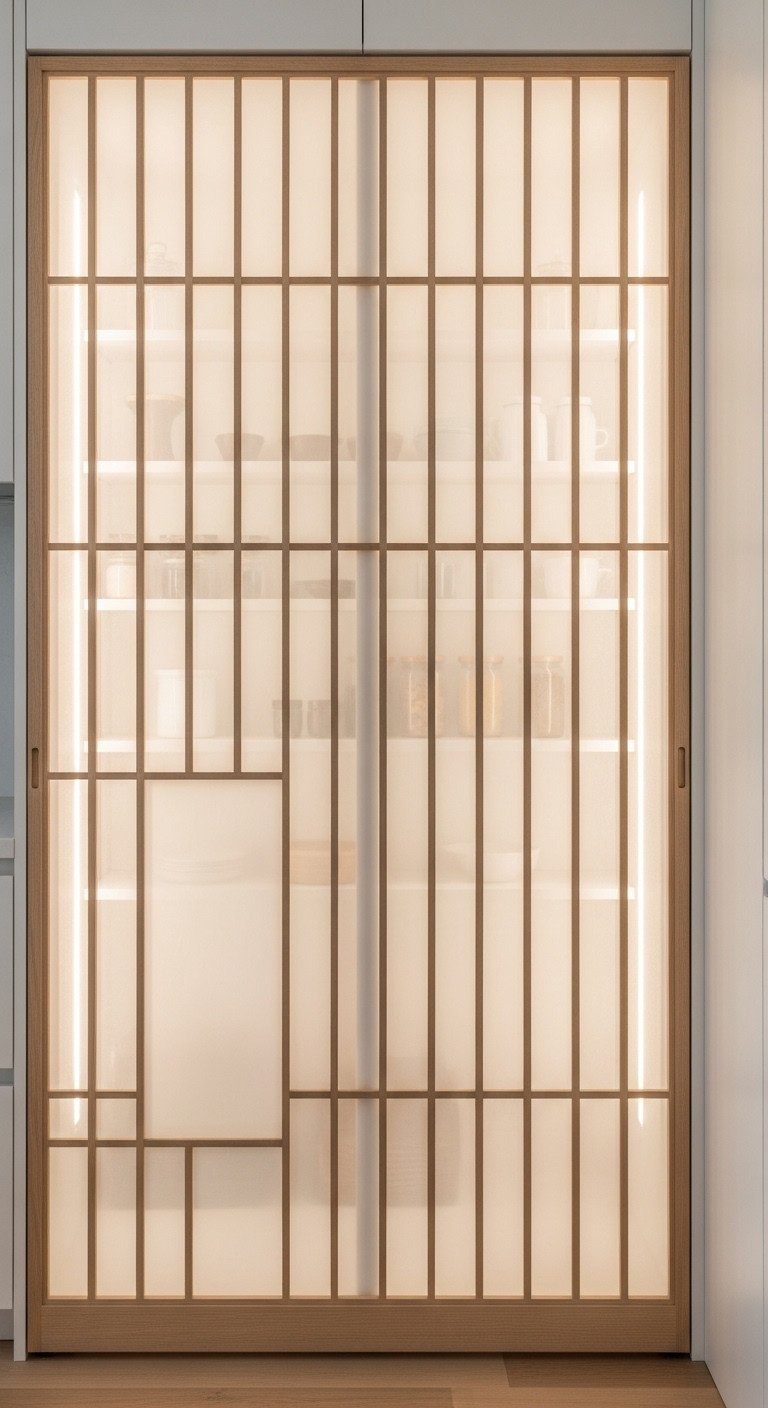
Save this unique idea for a touch of Japanese tradition!
- Materials Needed: Translucent window film, thin wood trim, wood glue, measuring tape.
- Step-by-Step Directions:
- For a simple, high-impact DIY project, you can create a beautiful Shoji-inspired effect on any existing glass cabinet doors.
- First, measure your glass panels carefully. Cut a piece of high-quality translucent rice paper-patterned window film to the exact size.
- Apply the film to the inside of the glass according to the product’s instructions. This provides the delicate look of traditional Shoji paper while being far more durable and easy to clean.
- For the iconic lattice effect, cut thin pieces of basswood or poplar trim to create a simple grid pattern on the outside of the glass. You can paint or stain the wood to match your cabinets and attach it with a strong adhesive.
Pro-Tip: This technique isn’t just for cabinets. A freestanding Shoji screen can be a beautiful and flexible way to partition an open-plan kitchen and dining area, elegantly defining the space without blocking precious light.
11. Focus on Functional, Quality Craftsmanship
Both Japanese and Scandinavian design traditions share a deep respect for high-quality craftsmanship and thoughtful, functional design. This means prioritizing well-made pieces that are durable and serve a clear purpose, shifting the focus from quantity to enduring quality.
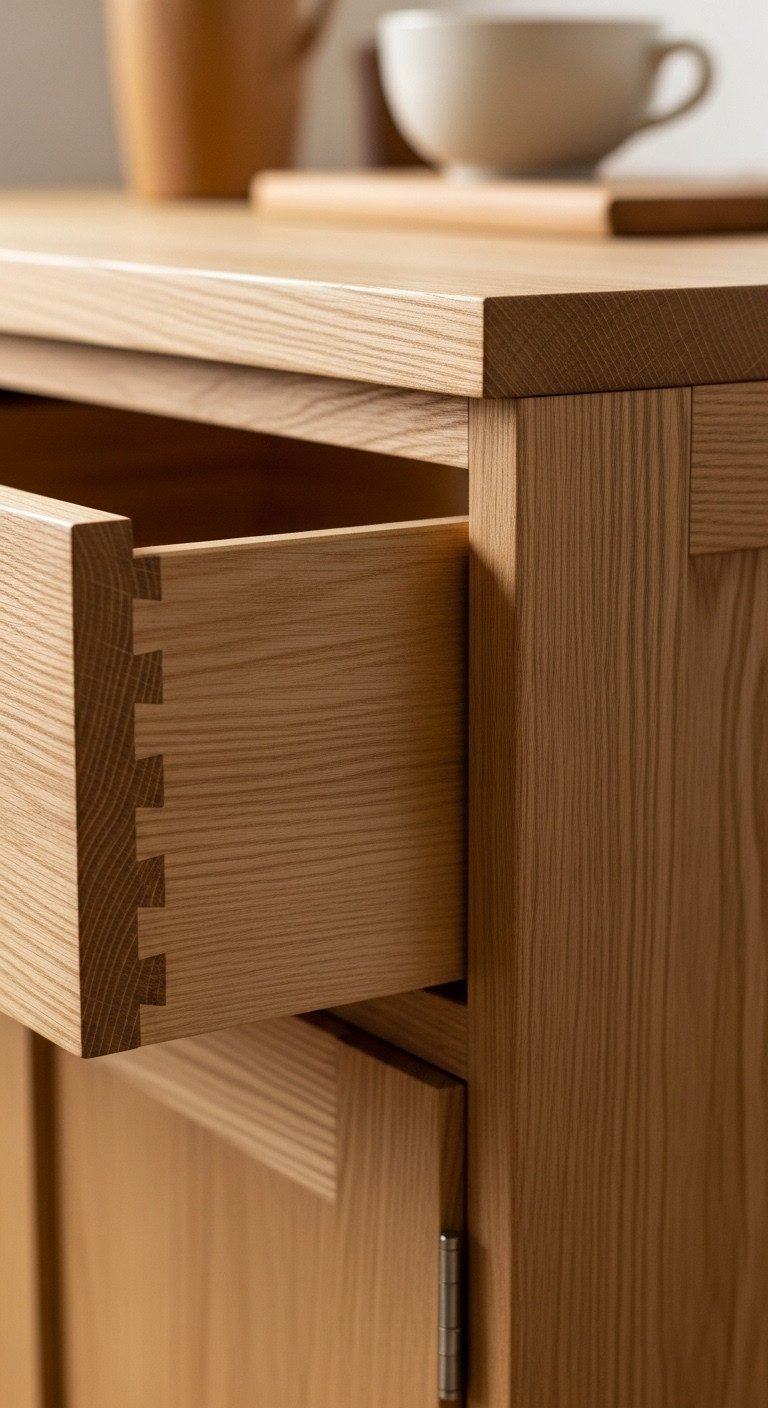
A reminder that quality matters! Pin this for inspiration.
- Materials Needed: High-quality chef’s knife, cast iron skillet, durable cookware.
- Step-by-Step Directions:
- Invest in fewer, better things. Instead of a large, clunky block of mediocre knives, invest in one exceptional, high-carbon steel Japanese Santoku knife. A quality knife that holds its edge will last a lifetime and make cooking a genuine pleasure.
- Choose cookware made from durable, long-lasting materials like cast iron, carbon steel, or multi-ply stainless steel. These pieces offer superior performance and will outlast typical non-stick pans many times over.
- When buying any new item for your kitchen, from a spatula to a stool, ask yourself: “Is this well-made? Does it serve a clear purpose?” This simple mindset naturally shifts your focus from quantity to quality.
- A high-quality Japanese rice cooker is a perfect example of functional craftsmanship; it’s a specialized appliance designed to perform one task perfectly for years to come.
Lesson Learned: Quality doesn’t always mean expensive. A simple, well-seasoned cast iron skillet is an incredibly affordable piece of cookware that embodies durability and functionality, and it only gets better with every use.
Key Takeaways: Your Quick Guide to a Minimalist Japanese Kitchen
To quickly review, creating a serene, minimalist Japanese kitchen comes down to five core principles. Remembering these will help you make intentional choices as you transform your space.
- Less is More: The foundation is a clutter-free environment. Everything must have a purpose and a place.
- Nature is Key: Prioritize natural materials like wood and stone, use an earthy color palette, and bring in plants and natural light.
- Function First: Design your space for optimal workflow and invest in high-quality, durable tools and furnishings that are built to last.
- Embrace Imperfection: Find beauty in the unique character of handmade items and materials that age gracefully (Wabi-sabi).
- Clean Lines Rule: Opt for simple, sleek forms, such as handleless flat-panel cabinets, to create a sense of calm and order.
People Also Ask About Minimalist Japanese Kitchens
Here are answers to some of the most common questions people have when exploring this beautiful and functional design style.
What is the Japanese minimalist style called?
The Japanese minimalist style is often associated with the “Wabi-sabi” philosophy, which finds beauty in imperfection and simplicity. When blended with Scandinavian design, it’s popularly called “Japandi.” This hybrid style emphasizes natural materials, functionality, and a serene, uncluttered aesthetic grounded in the “less is more” principle.
How do I create a Japandi kitchen on a budget?
You can start by decluttering ruthlessly—this is free and has the biggest impact. Then, focus on paint, using a muted, neutral color palette. Incorporate natural textures with affordable bamboo accessories, linen tea towels, and simple ceramic pieces from thrift stores. DIY projects, like creating Shoji-inspired cabinet doors with window film, can also achieve the look for less.
While both styles value simplicity and natural materials, Japanese minimalism (Wabi-sabi) often embraces more rustic, imperfect, and darker earthy tones, celebrating asymmetry and age. Scandinavian minimalism (Hygge) leans towards a brighter, cozier feel with light woods, clean lines, and a focus on creating a comfortable, contented atmosphere. Japandi style beautifully merges the two.
Final Thoughts
Creating a minimalist Japanese kitchen is more than just a design choice; it’s a meaningful step towards a more intentional and peaceful daily life. By focusing on the core principles of simplicity, nature, and function, you can transform your kitchen from a place of chaotic stress into a serene sanctuary that truly nurtures you. It’s about crafting a space that is not only beautiful to look at but also a joy to use every single day.
Which of these ideas will you try first to bring a sense of calm to your kitchen? Let us know in the comments below
Last update on 2025-12-03 at 15:06 / Affiliate links / Images from Amazon Product Advertising API
